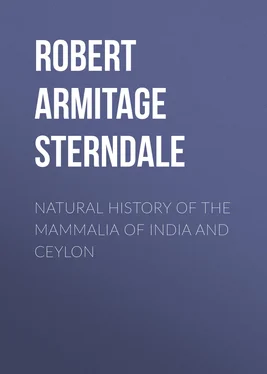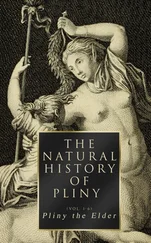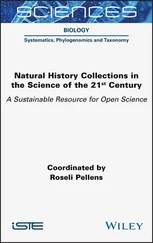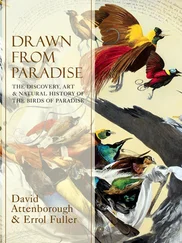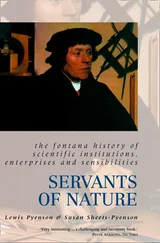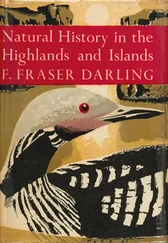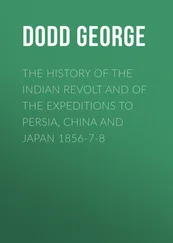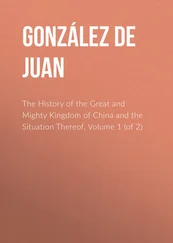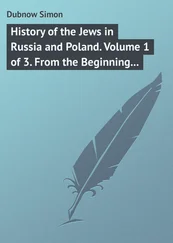Robert Armitage Sterndale - Natural History of the Mammalia of India and Ceylon
Здесь есть возможность читать онлайн «Robert Armitage Sterndale - Natural History of the Mammalia of India and Ceylon» — ознакомительный отрывок электронной книги совершенно бесплатно, а после прочтения отрывка купить полную версию. В некоторых случаях можно слушать аудио, скачать через торрент в формате fb2 и присутствует краткое содержание. Жанр: foreign_edu, Биология, на английском языке. Описание произведения, (предисловие) а так же отзывы посетителей доступны на портале библиотеки ЛибКат.
- Название:Natural History of the Mammalia of India and Ceylon
- Автор:
- Жанр:
- Год:неизвестен
- ISBN:нет данных
- Рейтинг книги:5 / 5. Голосов: 1
-
Избранное:Добавить в избранное
- Отзывы:
-
Ваша оценка:
- 100
- 1
- 2
- 3
- 4
- 5
Natural History of the Mammalia of India and Ceylon: краткое содержание, описание и аннотация
Предлагаем к чтению аннотацию, описание, краткое содержание или предисловие (зависит от того, что написал сам автор книги «Natural History of the Mammalia of India and Ceylon»). Если вы не нашли необходимую информацию о книге — напишите в комментариях, мы постараемся отыскать её.
Natural History of the Mammalia of India and Ceylon — читать онлайн ознакомительный отрывок
Ниже представлен текст книги, разбитый по страницам. Система сохранения места последней прочитанной страницы, позволяет с удобством читать онлайн бесплатно книгу «Natural History of the Mammalia of India and Ceylon», без необходимости каждый раз заново искать на чём Вы остановились. Поставьте закладку, и сможете в любой момент перейти на страницу, на которой закончили чтение.
Интервал:
Закладка:
Robert Armitage Sterndale
Natural History of the Mammalia of India and Ceylon
PREFACE
This work is designed to meet an existing want, viz.: a popular manual of Indian Mammalia. At present the only work of the kind is one which treats exclusively of the Peninsula of India, and which consequently omits the more interesting types found in Assam, Burmah, and Ceylon, as well as the countries bordering the British Indian Empire on the North. The geographical limits of the present work have been extended to all territories likely to be reached by the sportsman from India, thus greatly enlarging the field of its usefulness.
The stiff formality of the compiled "Natural Histories" has been discarded, and the Author has endeavoured to present, in interesting conversational and often anecdotal style, the results of experience by himself and his personal friends; at the same time freely availing himself of all the known authorities upon the subject.
INTRODUCTION
In laying before the public the following history of the Indian Mammalia, I am actuated by the feeling that a popular work on the subject is needed, and would be appreciated by many who do not care to purchase the expensive books that exist, and who also may be more bothered than enlightened by over-much technical phraseology and those learned anatomical dissertations which are necessary to the scientific zoologist.
Another motive in thus venturing is, that the only complete history of Indian Mammalia is Dr. Jerdon's, which is exhaustive within the boundaries he has assigned to India proper; but as he has excluded Assam, Cachar, Tenasserim, Burmah, Arracan, and Ceylon, his book is incomplete as a Natural History of the Mammals of British India. I shall have to acknowledge much to Jerdon in the following pages, and it is to him I owe much encouragement, whilst we were together in the field during the Indian Mutiny, in the pursuit of the study to which he devoted his life; and the general arrangement of this work will be based on his book, his numbers being preserved, in order that those who possess his 'Mammals of India' may readily refer to the noted species.
But I must also plead indebtedness to many other naturalists who have left their records in the 'Journals of the Asiatic Society' and other publications, or who have brought out books of their own, such as Blyth, Elliott, Hodgson, Sherwill, Sykes, Tickell, Hutton, Kellaart, Emerson Tennent, and others; Col. McMaster's 'Notes on Jerdon,' Dr. Anderson's 'Anatomical and Zoological Researches,' Horsfield's 'Catalogue of the Mammalia in the Museum of the East India Company,' Dr. Dobson's 'Monograph of the Asiatic Chiroptera,' the writings of Professors Martin Duncan, Flowers, Kitchen Parker, Boyd Dawkins, Garrod, Mr. E. R. Alston, Sir Victor Brooke and others; the Proceedings and Journals of the Zoological, Linnean, and Asiatic Societies, and the correspondence in The Asian ; so that after all my own share is minimised to a few remarks here and there, based on personal experience during a long period of jungle life, and on observation of the habits of animals in their wild state, and also in captivity, having made a large collection of living specimens from time to time.
As regards classification, Cuvier's system is the most popular, so I shall adopt it to a certain extent, keeping it as a basis, but engrafting on it such modifications as have met with the approval of modern naturalists. For comparison I give below a synopsis of Cuvier's arrangement. I have placed Cetacea after Carnivora, and Edentata at the end. In this I have followed recent authors as well as Jerdon, whose running numbers I have preserved as far as possible for purposes of reference.
Cuvier divides the Mammals into nine orders, as follows. ( The examples I give are Indian ones, except where stated otherwise ):—
Order I .—BIMANA. Man.
Order II .—QUADRUMANA. Two families—1st, Apes and Monkeys; 2nd, Lemurs.
Order III .—CARNARIA. Three families—1st, Cheiroptera , Bats; 2nd, Insectivora , Hedgehogs, Shrews, Moles, Tupaiæ, &c.; 3rd, Carnivora : Tribe 1, Plantigrades , Bears, Ailurus, Badger, Arctonyx; 2, Digitigrades , Martens, Weasels, Otters, Cats, Hyænas, Civets, Musangs, Mongoose, Dogs, Wolves and Foxes.
Order IV .—MARSUPIATA. Implacental Mammals peculiar to America and Australia, such as Opossums, Dasyures, Wombats, and Kangaroos. We have none in India.
Order V .—RODENTIA. Squirrels, Marmots, Jerboas, Mole-Rats, Rats, Mice, Voles, Porcupines, and Hares.
Order VI .—EDENTATA, or toothless Mammals, either partially or totally without teeth. Three families—1st, Tardigrades , the Sloths, peculiar to America; 2nd, Effodientia , or Burrowers, of which the Indian type is the Manis, but which includes in other parts of the world the Armadillos and Anteaters; 3rd, Monotremata , Spiny Anteaters or Echidnas, and the Ornithorynchus.
Order VII .—PACHYDERMATA, or thick-skinned Mammals. Three families—1st, Proboscidians , Elephants; 2nd, Ordinary Pachyderms , Rhinoceroses, Hogs; 3rd, Solidungula , Horses.
Order VIII .—RUMINANTIA, or cud-chewing Mammals. Four families—1st, Hornless Ruminants , Camels, Musks; 2nd, Cervidæ , true horns shed periodically, Deer; 3rd, Persistent horns , Giraffes; 4th, Hollow-horned Ruminants , Antelopes, Goats, Sheep and Oxen.
Order IX. —CETACEA. Three families—1st, Herbivorous Cetacea , Manatees, Dugongs; 2nd, Ordinary Cetacea , Porpoises; 3rd, Balænidæ , Whales.
ORDER BIMANA
Some people have an extreme repugnance to the idea that man should be treated of in connection with other animals. The development theory is shocking to them, and they would deny that man has anything in common with the brute creation. This is of course mere sentiment; no history of nature would be complete without the noblest work of the Creator. The great gulf that separates the human species from the rest of the animals is the impassable one of intellect. Physically, he should be compared with the other mammals, otherwise we should lose our first standpoint of comparison. There is no degradation in this, nor is it an acceptance of the development theory. To argue that man evolved from the monkey is an ingenious joke which will not bear the test of examination, and the Scriptural account may still be accepted. I firmly believe in man as an original creation just as much as I disbelieve in any development of the Flying Lemur ( Galeopithecus ) from the Bat, or that the habits of an animal would in time materially alter its anatomy, as in the case of the abnormal length of the hind toe and nail of the Jacana. It is not that the habit of running over floating leaves induced the change, but that an all-wise Creator so fashioned it that it might run on those leaves in search of its food. I accept the development theory to the extent of the multiplication of species, or perhaps, more correctly, varieties in genera. We see in the human race how circumstances affect physical appearance. The child of the ploughman or navvy inherits the broad shoulders and thick-set frame of his father; and in India you may see it still more forcibly in the difference between Hindu and Mahomedan races, and those Hindus who have been converted to Mahomedanism. I do not mean isolated converts here and there who intermarry with pure Mahomedan women, but I mean whole communities who have in olden days been forced to accept Islam. In a few generations the face assumes an unmistakable Mahomedan type. It is the difference in living and in thought that effects this change.
Читать дальшеИнтервал:
Закладка:
Похожие книги на «Natural History of the Mammalia of India and Ceylon»
Представляем Вашему вниманию похожие книги на «Natural History of the Mammalia of India and Ceylon» списком для выбора. Мы отобрали схожую по названию и смыслу литературу в надежде предоставить читателям больше вариантов отыскать новые, интересные, ещё непрочитанные произведения.
Обсуждение, отзывы о книге «Natural History of the Mammalia of India and Ceylon» и просто собственные мнения читателей. Оставьте ваши комментарии, напишите, что Вы думаете о произведении, его смысле или главных героях. Укажите что конкретно понравилось, а что нет, и почему Вы так считаете.
